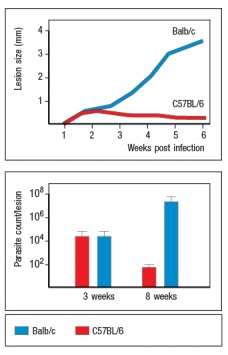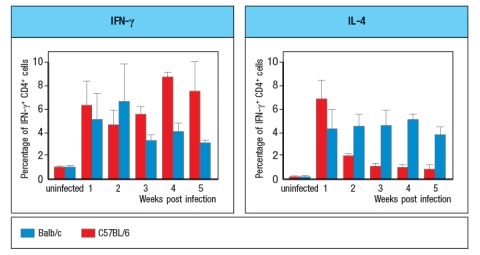Essay
Synthesis question: Leishmania parasites are intracellular protozoa that causes skin sores, and in some individuals, infections that spread systemically and cause damage to internal organs. In mice, different strains of inbred mice have varying responses to the Leishmania parasite Leishmania major. Whereas C57BL/6 mice develop self-healing skin lesions following infection, Balb/c mice develop non-healing lesions and ultimately succumb to systemic, fatal disease. An example of such data is shown in Figure Q28)A. For these studies, mice were infected with 2 106 L. major promastigotes in the footpad, and the sizes of skin lesions and the numbers of parasites per lesion were measured at the indicated times post-infection.  An example of the cytokine data from L. major infected mice is shown in Figure Q28)B. At the indicated times the percentages of CD4 T cells in the draining lymph node producing IFN- versus IL-4 following stimulation with L. major antigens were measured by intracellular cytokine staining.
An example of the cytokine data from L. major infected mice is shown in Figure Q28)B. At the indicated times the percentages of CD4 T cells in the draining lymph node producing IFN- versus IL-4 following stimulation with L. major antigens were measured by intracellular cytokine staining. 
on TH1 effector T cells, CD8 effector T cells, and NK cells. These chemokines are normally not detectable in healthy tissues, but are strongly up-regulated during infection, injury or inflammation, in response to IFN- production in the tissue.
d) How might this information help explain the divergent ability of C57BL/6 versus Balb/c mice to accumulate increasing numbers of effector T cells into the L. major lesions over the long timecourse shown in the data above?
Correct Answer:

Verified
a) Difference in T cell migration into t...View Answer
Unlock this answer now
Get Access to more Verified Answers free of charge
Correct Answer:
Verified
View Answer
Unlock this answer now
Get Access to more Verified Answers free of charge
Q2: Infections of intracellular pathogens (e.g., mycobacteria, listeria,
Q3: Hyper-IgE syndrome, also known as Job’s
Q4: Nitric oxide and superoxide radicals are toxic
Q5: In addition to producing distinct innate responses
Q6: Helicobacter pylori is a human gastrointestinal (GI)
Q8: The generation of optimal CD8 T cell
Q9: Leprosy is a disease caused by the
Q10: Immunological memory in humans has been examined
Q11: One of the first studies using peptide:MHC
Q12: IL-23 is a cytokine made by macrophages